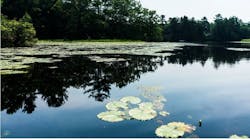The Samsung facility in northwest Austin, Texas, spilled up to 763,000 gallons of acidic waste into their storm water pond and an unnamed tributary of Harris Branch Creek.
This occurred over a period as long as 106 days, according to a memorandum sent to the Austin City Council.
According to the memo sent by the Watershed Protection Department (WPD) to the council, it is unknown exactly how much waste entered the tributary, and WPD staff found virtually no surviving aquatic life within the entire tributary from the Samsung property to the main branch of Harris Branch Creek, near Harris Branch Parkway.
No measurable impacts to water chemistry or aquatic life were noted further downstream. Additionally, there was no iron staining to indicate any drop in pH had occurred within the main branch the creek Creek.
WPD was alerted to the discharge on Jan. 18 by the Texas Commission on Environmental Quality (TCEQ).
Samsung notified TCEQ and the National Response Center about the discharge on Jan. 14, according to the memo. Sections of the tributary had a pH of between 3 and 4, which is not normal for surface water.
The storm water pond valves were closed and isolated and staff surveyed downstream. Further assessment of the tributary on Jan. 19 found pH had returned close to normal levels, according to the memo.
Environmental scientists also found remains of dead aquatic species and almost no surviving aquatic life within the affected area. No impacts were noted within the main branch of Harris Branch Creek, however.
WPD is receiving daily updates from Samsung on the remediation process at the storm water pond and will inspect the pond before it is allowed to be put back in service.






